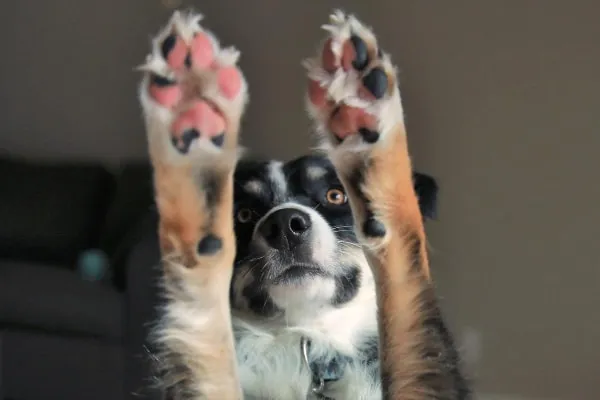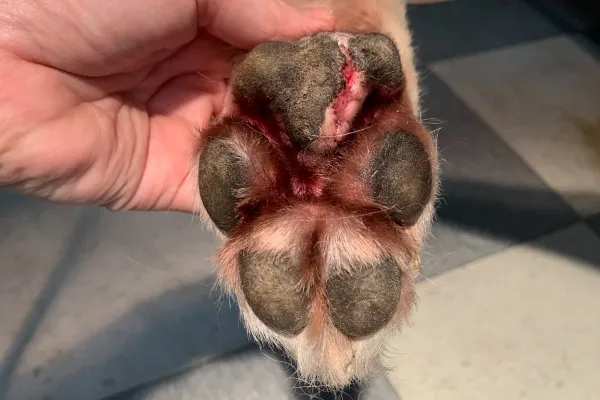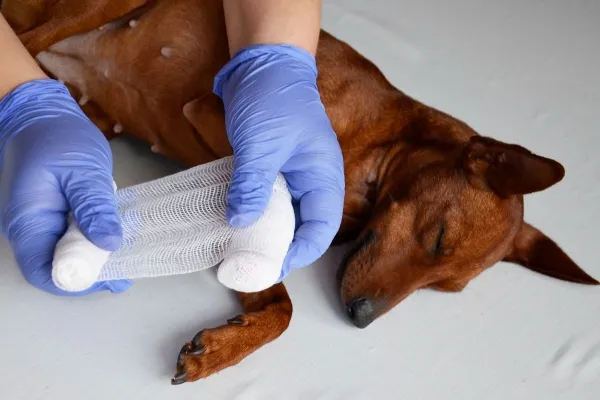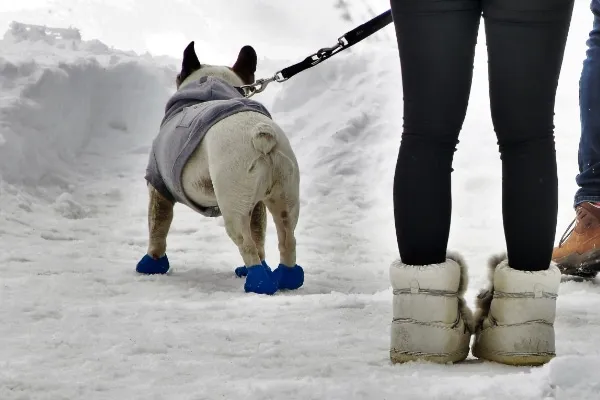A dog paw pad injury can range from minor cuts to severe burns. Understanding how to address these injuries promptly and effectively is crucial for your dog’s well-being. Integrative veterinarian Dr. Julie Buzby provides a detailed guide on identifying, treating, and preventing paw pad injuries in dogs, ensuring your furry friend stays comfortable and active.
 Dog with his pawpads up in the air
Dog with his pawpads up in the air
Why are Paw Pads Important for Dogs?
A dog’s paws are essential for their overall health and mobility. They provide support, cushioning, and protection, allowing your dog to walk, run, and play comfortably. The paw pads specifically play a vital role by:
- Providing Cushioning: Thick, squishy foot pads absorb impact, reducing strain on bones and joints.
- Enhancing Traction: Paw pads, combined with toenails, offer excellent grip on various terrains.
- Protecting from Extreme Temperatures: Paw pads act as a barrier against hot and cold surfaces.
Common Types of Dog Paw Pad Injuries
Given their constant contact with the ground, paw pads are susceptible to various injuries, including:
Foreign Bodies
Sharp objects like glass, foxtails, nails, or splinters can puncture the paw pad, causing pain and potential infection. If your dog has crusty scabs on his back home remedies might not work for this.
Cuts and Lacerations
Cuts occur when a sharp object slices the paw pad. These can range from superficial scratches to deep wounds.
 Close up of a dog
Close up of a dog
Paw Pad Flaps
Similar to cuts, flaps involve a larger surface area, often resulting from horizontal slicing of the paw pad. Untreated cuts can also develop into flaps as the tissue tears.
Burns
Hot pavement, ice, ice melt products, or caustic substances can cause burns on your dog’s paw pads. This is especially common during summer months.
Ingrown Toenails
Overgrown nails can curl and penetrate the paw pad, leading to pain, infection, and discomfort. Regular trimming of your dog’s toenails can prevent this issue.
Recognizing a Paw Pad Injury
Several signs can indicate that your dog has a paw pad injury:
- Sudden limping or lameness
- Crying out when putting weight on the affected paw
- Reluctance to put pressure on the paw
- Bleeding from the paw pad
- Excessive licking or biting at the paw
- Swelling, discoloration, or redness
- Visible cuts, punctures, flaps, or foreign objects
First Aid Steps for Paw Pad Injuries
If you suspect your dog has a paw pad injury, follow these first aid steps:
Evaluate Your Dog: Assess your dog’s attitude and overall condition. If your dog seems severely painful, it’s best to seek veterinary care.
Inspect the Paw: Carefully examine the paw, including the top and bottom, paw pads, and area between the toes. Identify any cuts, punctures, burns, or visible objects.
Remove Foreign Objects (If Safe) and Stop Bleeding:
- 3a: For small, superficial objects, remove them gently with tweezers. For deeply lodged objects, consult your vet immediately.
- 3b: If the wound is bleeding, apply pressure with a clean cloth for a few minutes. If bleeding doesn’t stop within 10-15 minutes, seek immediate veterinary attention.
Clean the Wound: Use cool water and gentle antibacterial soap, chlorhexidine, or betadine to clean the wound thoroughly.
Apply a Bandage: Use clean materials like gauze and vet wrap to bandage the paw, ensuring it’s not too tight. Watch for signs of restricted circulation. If you need a refresher, read my dog has crusty scabs on his back home remedies.
 Dog getting their foot bandaged
Dog getting their foot bandaged
- Contact Your Veterinarian: Follow up with your vet for further evaluation and treatment.
Veterinary Treatment for Paw Pad Injuries
During a veterinary appointment, the vet will:
- Perform a physical examination
- Assess the paw for cuts, punctures, burns, or other injuries
- Palpate and manipulate the bones and joints
- Recommend X-rays to identify foreign objects or bone/joint involvement
Treatment options may include:
- Trimming hair around the wound
- Cleaning the wound and removing debris
- Applying antibacterial ointment or soothing cream
- Bandaging the foot to control bleeding, prevent re-injury, and keep the wound clean
Preventing Future Paw Pad Injuries
Preventing paw pad injuries is crucial for maintaining your dog’s health. Consider these precautions:
- Avoid extreme temperatures by timing walks carefully and revising routes.
- Use protective dog booties like PawZ dog boots.
- Wash your dog’s feet after walks to remove ice melt products or chemicals.
- Inspect your dog’s feet for foxtails after outdoor trips.
- Regularly trim your dog’s nails.
- Be vigilant for hazards along paths and trails.
 Dog wearing paw boots out in the snow as protection from foot pad injuries
Dog wearing paw boots out in the snow as protection from foot pad injuries
Conclusion
Paw pad injuries can be distressing for both you and your dog. By understanding the causes, symptoms, and first aid steps, you can provide immediate care and seek appropriate veterinary treatment. With prompt attention and preventative measures, your dog can recover quickly and return to enjoying an active, pain-free life.
